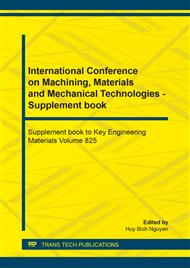[1]
Norman S. Currey, Aircraft Landing Gear Design: Principle and Practices, American Institute of Aeronautics and Astronautics, Washington, D.C. 1988, p.69 – 121.
Google Scholar
[2]
Benjamin Milwitzky and Francis E. Cook, Analysis of landing – Gear Behavior, Langley Aeronautical Laboratory Langley Field, Rep. 1154, May. (1948).
Google Scholar
[3]
John R. McGehee and Huey D. Carden, A mathematical model of an active control landing gear for load control during impact and roll – out, NASA Langley Research Center Hampton, Va. 23665, Rep. NASA TND -8080, February (1976).
Google Scholar
[4]
Gian Luca Ghiringhelli, Testing of Semi – Active Landing Gear Control for a General Aviation Aircraft, Journal of Aircraft, Vol.37, No. 4, p.606 – 616, July – August (2000).
DOI: 10.2514/2.2672
Google Scholar
[5]
Luong Quoc Viet and et al, Control of Intelligent landing gear with Magneto-Rheological damper, SASE 2017 Fall Conference, pp.401-402.
Google Scholar
[6]
Li Hua – Lin, Fuzzy PID Control for Landing Gear based on Magneto-Rheological (MR) damper, Apperceiving Computing and Intelligence Analysis, 2009. ICACIA 2009, p.22 – 25, October. (2009).
DOI: 10.1109/icacia.2009.5361162
Google Scholar
[7]
Liu Hui, Application of High – Speed Solenoid Valve to the Semi – Active Control of Landing Gear, Chinese Journal of Aeronautics 21 (2008) 232-240, p.232 – 240, January (2008).
DOI: 10.1016/s1000-9361(08)60030-8
Google Scholar
[8]
X.M. Dong and G.W. Xiong, Vibration Attention of Magnetorheological Landing Gear System with Human Simulated Intelligent Control, Mathematical Problems in Engineering Volume 2013, Article ID 242476, October (2013).
DOI: 10.1155/2013/242476
Google Scholar
[9]
Ajinkya A. Gharapurkar, Robust Semi – Active Control of Aircraft Landing Gear System Equipped with Magnetorheological Dampers, M.S. thesis, Department of Mechanical Engineering, Concordia University, Montreal, Quebec Canada, (2014).
Google Scholar
[10]
Young – Tai Choi and Norman M. Wereley, Vibration Control of a Landing Gear System Featuring Electrorheological/Magnetorheological Fluids, Journal of Aircraft Vol. 40, No.3, p.432 – 439, May – June (2003).
DOI: 10.2514/2.3138
Google Scholar
[11]
G. Mikulowski, Adaptive aircraft shock absorbers, AMAS Workshop on Smart Materials and Structures, SMART'03, p.63 – 72, September. (2003).
Google Scholar
[12]
Louise A. Powell, Magnetorheological Fluids and Applications to Adaptive Landing Gear for a Lightweight Helicopter, Ph.D. dissertation, Department of Aerospace Engineering, University of Maryland, College Park, Maryland, (2014).
Google Scholar
[13]
Tak, Jun Mo, A Hybrid Control Technique of the Intelligent Landing Gear with Variable Damping Force, M.S. thesis, Department of Mechanical Engineering, Korean Aerospace University, (2017).
Google Scholar
[14]
Seung – Bok Choi and Young – Min Han, Fluid Technology Applications in vehicle systems, CRC Press Taylor & Francis Group, p.2 – 11, (2013).
Google Scholar


